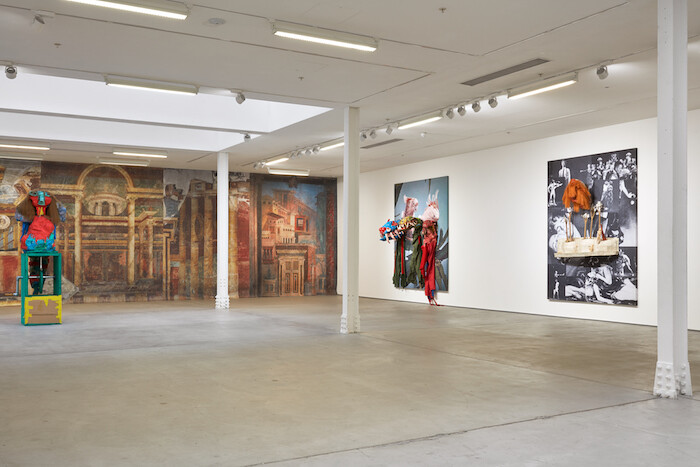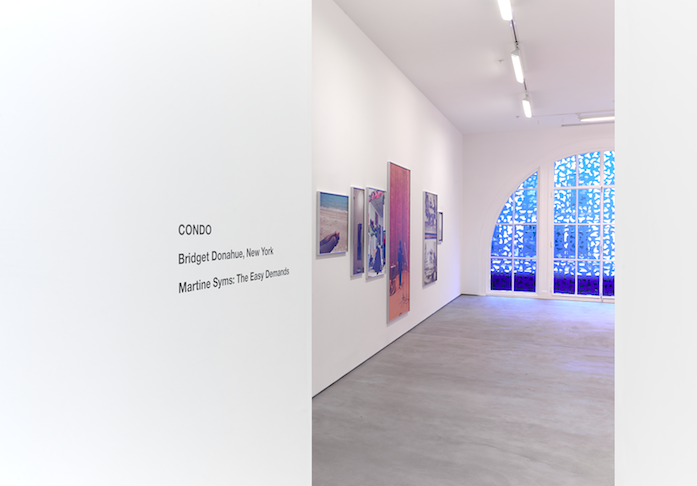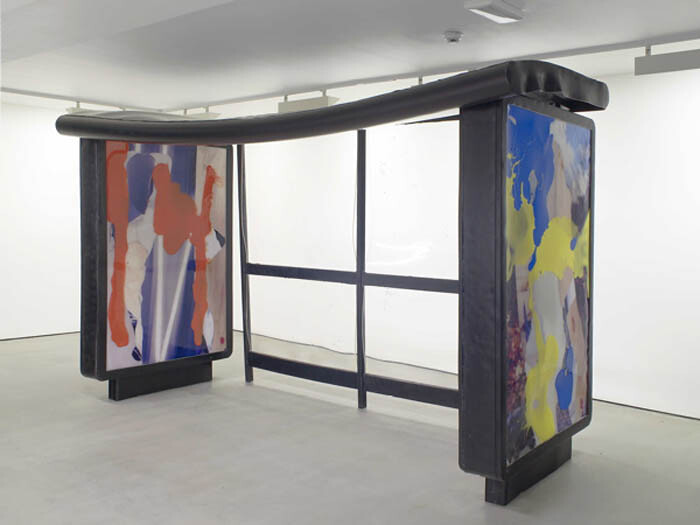Categories
Subjects
Authors
Artists
Venues
Locations
Calendar
Filter
Done
March 21, 2018 – Review
Marvin Gaye Chetwynd’s "Ze & Per"
Philomena Epps

Marvin Gaye Chetwynd’s practice, with its hubbub of miscellaneous and licentious references, evokes a mood of historic and anthropological ambiguity. Her works enmesh periods of cultural rebellion over the centuries, from medieval history, folk plays, and pagan festivals, to the genesis of Dada, and from the DIY culture of drag balls and punk to alternative living, squatting, and co-ops. Chetwynd’s spontaneous intertwining of performance, installation, video, sculpture, and painting can also be figured within the space of play: an arena dedicated to experimentation and risk without a predetermined outcome. This gesture toward facilitating an impermanent escape from reality is best read through Mikhail Bakhtin’s theories of the carnivalesque: free interaction between people; eccentric or non-traditional behavior; sacrilegious events; and the nonsensical (mis)alliance of opposites. Absurdity, humor, and hyperbole are de rigueur. The world is upside down. The body is inside out.
Chetwynd’s topsy-turvy approach to performance is expressed in a quieter register in her solo show at Sadie Coles HQ. Ten colorful, collage-like pieces are hung on the gallery’s walls, while three illustrative paintings—one (Samurai Bat) depicts a bat’s head; another (Dulac’s Perman, both works 2018) shows a carp eating from a mermaid’s palm—lean against walls and columns in thick gold …
February 7, 2017 – Review
Martine Syms’s “The Easy Demands”
Morgan Quaintance

What’s to be gained from aestheticizing resistance, from reducing political protest and its violent and repressive fallout to a highly stylized image? This is the final question raised by Martine Syms’s second solo show in London, a tastefully oblique, risk-free display that simultaneously draws on and hollows out the recent history of African American-led demonstrations against police brutality and institutional racism.
Installed in a modest gallery accessible through the main expanse of Sadie Coles HQ, temporary host to New York’s Bridget Donahue during Condo, “The Easy Demands” brings together three works: a structural intervention, a single-channel video loop, and a collection of photographic prints. Although superficially unified by being presented in the same space, they remain conceptually and aesthetically disconnected; in fact, the exhibition operates on and fosters an attitude of detachment. It is a dynamic that surfaces in relation to the works on show, in the relationship between the artist and host institution, and in the spectatorial mode produced by the gallery’s oppressive air of exclusivity, which Syms frustratingly does not disrupt.
Belief Strategy XIII (2016) is a dappled color filter applied to the oval window covering one end of the gallery. To create it Syms has appropriated a tool from …
May 11, 2012 – Review
Gabriel Kuri’s “Classical Symmetry, Historical Data, Subjective Judgement”
Lorena Muñoz-Alonso

Contingency and probability are long-standing conceptual interests for Mexican artist Gabriel Kuri. His 2011 exhibition at South London Gallery was titled “Before Contingency After the Fact,” for example. His current show at Sadie Coles is titled “Classical Symmetry, Historical Data, Subjective Judgement,” which, according to statistician David Spiegelhalter, are the three essential considerations for calculating the probability of an event. Still, the contingencies Kuri might be concerned with remain elusive and unspecified here, and the sculptures gathered in this show successfully convey that sense of impermanence and open-endedness.
In the room upstairs, six wall sculptures made of gilded insulating foam form a sequence of self-portraits where genre is also mutable or provisional. Some of them remind me of Hannah Wilke’s famous vaginal sculptures from the 1970s, made of chewing gum folded onto itself. Kuri’s larger and brighter sculptures, however, depart from Wilke’s feminist politics to revel in their own theatricality. In Recurring Flat Line Chart (all works 2012), for example, a plastic bag containing liquid bearing an uncanny likeness to urine hangs from what looks like the torso and upper legs of an overweight creature. In Double Self Portrait (Two Point Crossed Section Chart) that same shape becomes a face by …
November 1, 2010 – Review
Angus Fairhurst at Sadie Coles HQ, London
Karen Archey

Beyond the overwhelming personal tragedy, one of the many unfortunate consequences of suicide is that a life’s work is often mitigated through the lens of it. For Angus Fairhurst’s first gallery exhibition since his 2008 suicide, it is at once impossible to elide this tragedy yet simultaneously a disservice to let the artist’s death supersede his work’s autonomy. Curated and installed by artists Rebecca Warren and Urs Fischer at Sadie Coles HQ in London, the exhibition seeks to join key works in Fairhurst’s career, ranging from intimate graphite drawings to various sculptures to a larger installation downstairs. Most compellingly on display are Fairhurst’s iconic bronze gorillas supported by newly constructed plinths in tribute to the artist. Commissioned by Warren and Fischer, the plinths range from a hefty, inscribed cast iron totem (designed by Damien Hirst) to castoff cardboard banana boxes, all created by sundry fellow Young British Artists.
Fairhurst, a lesser-known contemporary of YBAs Sarah Lucas, Tracey Emin, and Gary Hume, rose to prominence in the early 1990s exhibiting throughout England and Europe. His infamous 1991 prank commenting on the insularity of the art world, “Gallery Connections,” put confused attendants of London art museums and galleries unwittingly in touch with one …
